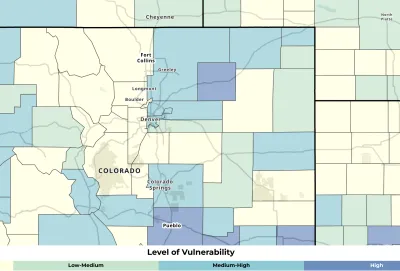The Social Vulnerability Index (SVI) is a resource that can be used by public agencies to identify parts of a community that are most in need of investment.

The Social Vulnerability Index (SVI) is a resource provided by the Centers for Disease Control and Prevention/Agency for Toxic Substances and Disease Registry (CDC/ATSDR). The SVI measures social vulnerability which is defined by CDC/ATSDR as the potential negative effects on communities caused by external stresses on human health.
The SVI is a valuable tool to identify communities that will most likely need support before, during and after a public health emergency. It uses 16 U.S. census variables to help local officials identify communities that may need support before, during, or after disasters. More broadly, SVI is an indicator of which areas of a community are considered “at risk” and most in need of investment to reduce vulnerability and increase overall health.
In this blog post, Austin Barrett of the National Recreation and Park Association (NRPA) highlights the SVI as a tool that can be used to help park and recreation agencies with their decision-making regarding future capital and operational investments. The SVI is one of the resources featured in NRPA's recently created Data and Mapping Resource Library which was previously discussed in in this article.
The use of vulnerability indicators is becoming more widespread as public agencies seek to identify and prioritize the most vulnerable areas and populations for planning, services, programs, and capital investments. For example, the Los Angeles County Department of Parks and Recreation (DPR) recently completed the Parks Needs Assessment Plus (PNA+) which uses indicators from the Healthy Places Index (HPI) and other data to identify where the most vulnerable residents are concentrated and determine which areas should be prioritized for conservation and restoration as well as regional and rural recreation.
FULL STORY: Featured Data Resource: Social Vulnerability Index

Analysis: Cybertruck Fatality Rate Far Exceeds That of Ford Pinto
The Tesla Cybertruck was recalled seven times last year.

National Parks Layoffs Will Cause Communities to Lose Billions
Thousands of essential park workers were laid off this week, just before the busy spring break season.

Retro-silient?: America’s First “Eco-burb,” The Woodlands Turns 50
A master-planned community north of Houston offers lessons on green infrastructure and resilient design, but falls short of its founder’s lofty affordability and walkability goals.

Test News Post 1
This is a summary

Analysis: Cybertruck Fatality Rate Far Exceeds That of Ford Pinto
The Tesla Cybertruck was recalled seven times last year.

Test News Headline 46
Test for the image on the front page.
Urban Design for Planners 1: Software Tools
This six-course series explores essential urban design concepts using open source software and equips planners with the tools they need to participate fully in the urban design process.
Planning for Universal Design
Learn the tools for implementing Universal Design in planning regulations.
EMC Planning Group, Inc.
Planetizen
Planetizen
Mpact (formerly Rail~Volution)
Great Falls Development Authority, Inc.
HUDs Office of Policy Development and Research
NYU Wagner Graduate School of Public Service

























